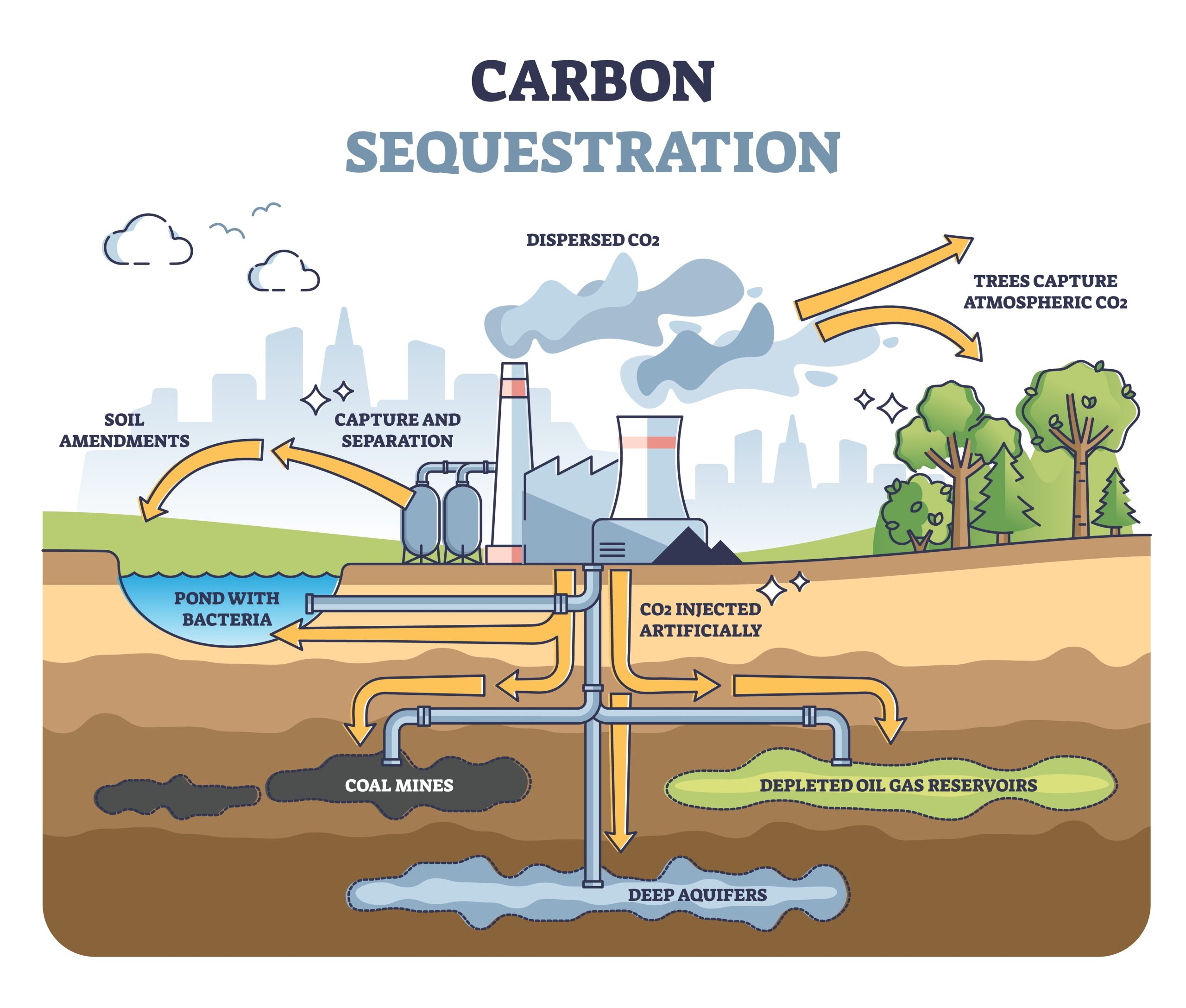Climate Solutions Now Act: Why Scrutinize Carbon Capture?
By Shawn Malluwa-wadu, Environmental Leader
———————————————————-
Need to know:
- Maryland has recently passed the Climate Solutions Now Act of 2022, requiring the state to reduce emissions by 60% in 2030, and to reach net zero by 20451.
- Maryland has implemented and continues to implement forms of carbon capture, but uses scrutinizing language regarding carbon capture as a method of reducing emissions in its emission reduction plan1.
- Carbon capture systems have a history of failure, with millions of dollars spent on coal plant carbon capture systems which never saw the light of day. There are also efficiency concerns which highlight the solution’s inability to meet the Climate Solutions Now Act’s aggressive demands.
- Maryland should instead focus its efforts towards decarbonizing industry, electricity, and automotives through infrastructure overhauls proven to work.
———————————————————-
Maryland’s fight against greenhouse emissions
The backbone of modern society is built on burning fossil fuels. This fundamental flaw in our post industrial society has been long ignored, and requires a strong legislature to fight. So what’s Maryland doing?
In 2021 Coal accounted for 20% of carbon emissions in the United States. Out of every state and Washington DC, Maryland comes 33rd in terms of coal carbon emissions2. With 9% of Maryland’s total energy being produced with coal3, reducing the amount of coal burned would go a long way towards carbon neutrality. With the signing of Climate Solutions Now Act of 2022, Maryland leads the way in aggressive climate policy. However, one controversial method of decarbonization was mentioned. The law reads: “MAY INCLUDE THE USE OF CARBON CAPTURE, ELECTRIC DISTRIBUTION AND TRANSMISSION INFRASTRUCTURE IMPROVEMENTS, AND STORAGE TECHNOLOGY… ONLY IF THE TECHNOLOGY HAS BEEN SCIENTIFICALLY PROVEN TO ACHIEVE VERIFIABLE CARBON REDUCTIONS4.” This Line places implications the law does not place on other methods of decarbonization. It effectively forbids any attempt to develop new carbon capture systems without significant data to prove it. Why place carbon capture under such scrutiny?
What is carbon capture?
Carbon capture and storage or CCS, is the process of capturing carbon dioxide either from the air or before it is emitted, and storing it someplace else5. The carbon dioxide is typically as a liquid underground, in depleted oil or gas reservoirs. These reservoirs are capable of storing the liquid carbon dioxide for over 1,000 years6. Additionally, carbon capture systems installed in fossil fuel electricity plants are theoretically capable of capturing 90% of carbon dioxide emitted5. There are a few obvious downsides, of course: the process is expensive and uses more fuel than a plant without a carbon capture system would. There are also concerns regarding the true efficiency of these systems, which will be addressed later. Maryland does currently partake in several carbon capture projects funded through other means rather than through the Climate solutions act, which have been successful.
Tree-Mendous Maryland is a Maryland forest service program which aims to enable citizens to plant trees in public or community spaces in the state. Reforesting is a common carbon capture program, with various benefits to our environment outside of sequestering carbon5. In urban settings, planting trees can reduce the urban heat island effect, where urban areas experience localized higher temperatures, by creating shade and releasing water vapor which helps lower temperatures by an average of 2-4 degrees fahrenheit7. The state of Maryland has even passed legislation to plant 5 million trees, 10% in redlined urban communities8.

Another important use of carbon capture technology is in cement plants. Capturing carbon directly as it’s emitted is one of the most productive methods of carbon capture, particularly compared to pulling it from the air. For example, talks at Union Bridge Cement Plant Carroll county have discussed further implementing carbon capture utilization and storage (CCUS) systems to reduce emissions produced at the plant, among other solutions9. But when it comes to tackling the climate crisis, why is Maryland not as open to taking advantage of carbon capture further than planting trees or CCUS through the Climate Solutions Now Act?
Limitations of Carbon Capture
Carbon capture is not short of limitations, even of its most promising aspects. Carbon sequestration through trees, for example, is ultimately temporary. When trees die or decay, a significant amount of carbon they sequestered re-enters the atmosphere. In forest environments, trees can only sequester so much carbon before they become saturated and unable to sequester any more10. Additionally, they may have negative societal impacts. People tend to view trees as an easy way to combat climate change, and so focus their efforts towards planting trees rather than much more dramatic solutions needed to address climate change.
When it comes to coal energy plant carbon capture systems, there is little positive to say. The U.S. The Government Accountability Office conducted an investigation into the Department of Energy funded 8 Carbon capture projects on coal plant sites. Between 2010 and 2017, 684 million were spent on eight coal plant carbon capture system projects. Three were scrapped, four were never finished, and the last shut down following mechanical issues11.
Plants don’t even need to resort to carbon capture systems to reduce their emissions. Cement Plants could instead focus on using resources which produce less emissions. For example, the Union Bridge Cement Plant has begun working with the Maryland Department of Environment to minimize emissions. “If we can produce cement with 7-8% reduced clinker, we should see a 7-8% reduction in CO2 emissions,” Kent Martin, Union Bridge Cement Plant Manager, explained when inquired upon methods of reduction9. This point becomes especially more prevalent when efficiency is taken into consideration. Jacobson is a professor of civil and environmental engineering at Stanford, who conducted a study on the true efficiency of carbon capture systems. While it is estimated that carbon capture systems could prevent 90% of emissions from entering the atmosphere, Jacobson found that they were only 55.4% efficient, without taking into account emissions created during the manufacturing and installation of the carbon capture system. This figure only gets worse if the system runs on non-renewable power.
The Fundamental Problem
These Examples highlight a fundamental problem with carbon capture. With its high cost to implement, its precedent for failure, (comparatively) minimal impact on emissions, and the existence of other solutions in the same fields, the technology isn’t capable of aggressive decreases in emissions that the Climate Solutions Now Act demands. it’s only natural that Maryland would place the method under scrutiny. Furthermore, Carbon capture systems within plants are a band-aid solution to a bigger systemic problem. When we capture the carbon a cement plant emits, we are enabling the continuation of producing those emissions in the first place. Focus should be placed more on using resources which produce less emissions, such as by reducing the amount of clinker used as in the case of the Union Bridge Cement Plant.
So what should we do instead?
While the official road map isn’t set to release until the end of this year, it’s easy to see many ways Maryland can quickly decarbonize. Given that the majority of Maryland’s emissions come from cars, power generation, and industry, We could incentivize electric vehicles, replace all our coal plants with renewables, and work with industry to use more sustainable materials. Rapidly investing in proven green infrastructure is the only way Maryland will reach its goal of net zero by 2045. Only time will tell whether or not we’ll succeed.
References
1 CCAN Action Fund. (2022, August 9). Climate solutions now – CCAN action fund. CCAN Action Fund – Chesapeake Climate Action Network Action Fund. Retrieved January 10, 2023, from https://ccanactionfund.org/maryland/climate-solutions-now/
2 EIA. (n.d.). U.S. Energy Information Administration – EIA – independent statistics and analysis. EIA. Retrieved January 10, 2023, from https://www.eia.gov/state/seds/
3 Majorenergy. (2022, August 10). Where does Maryland get its electricity? Major Energy. Retrieved January 10, 2023, from https://majorenergy.com/where-does-maryland-get-its-electricity/
4 Lawrence J. Hogan. (2022). Maryland. Senate Bill 528. Retrieved January 10, 2023, from https://mgaleg.maryland.gov/2022RS/Chapters_noln/CH_38_sb0528e.pdf
5 Grantham Research Institute. (2023, January 3). What is carbon capture and storage and what role can it play in tackling climate change? Grantham Research Institute on climate change and the environment. Retrieved January 10, 2023, from https://www.lse.ac.uk/granthaminstitute/explainers/what-is-carbon-capture-and-storage-and-what-role-can-it-play-in-tackling-climate-change/
6 Selin, N. Eckley (2019, January 16). carbon sequestration. Encyclopedia Britannica. https://www.britannica.com/technology/carbon-sequestration
7 U.S. Department of the Interior. (n.d.). Carbon storage by Urban Forests (U.S. National Park Service). National Parks Service. Retrieved January 10, 2023, from https://www.nps.gov/articles/000/uerla-trees-carbon-storage.htm#:~:text=Urban%20trees%20can%20help%20mitigate,from%20the%20air%20by%20plants
8 Maryland Department of the Environment. (n.d.). Maryland Department of the environment. Department of the Environment. Retrieved January 10, 2023, from https://mde.maryland.gov/programs/air/climatechange/pages/trees-commission.aspx
9 UMD School of Public Policy. (n.d.). CGS visits Maryland Cement Plant to discuss decarbonization efforts. UMD School of Public Policy. Retrieved January 10, 2023, from https://spp.umd.edu/news/cgs-visits-maryland-cement-plant-discuss-decarbonization-efforts
10 Climate Feedback. (2020, June 12). The potentials and limitations of tree plantings as a climate solution. Climate Feedback. Retrieved January 10, 2023, from https://climatefeedback.org/the-potentials-and-limitations-of-tree-plantings-as-a-climate-solution
11 John, J. S. (2022, January 5). US government squandered hundreds of millions on ‘clean coal’ pipe… Canary Media. Retrieved January 10, 2023, from https://www.canarymedia.com/articles/carbon-capture/us-government-squandered-hundreds-of-millions-on-clean-coal-pipedream
About the Author:

Shawn Malluwa-wadu, Seneca Valley High School, Class of 2023
In a world suffering under rampant climate change, Shawn believes environmental technology is our only way of mitigating future disaster. Shawn joined the Environmental Leaders Program to better understand what he can do within his community to support our local environment. Shawn majors in aerospace, and hopes to help develop eco-friendly aircraft in an industry which contributes immensely to carbon emissions, and hopes to use the Environmental Leaders Program to further understand what’s being done within the aviation industry regarding climate change.





